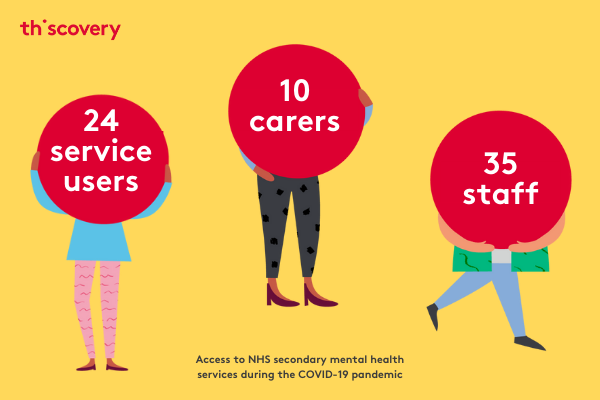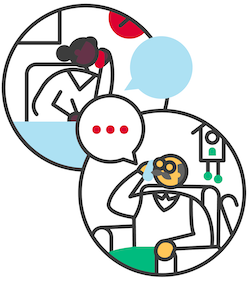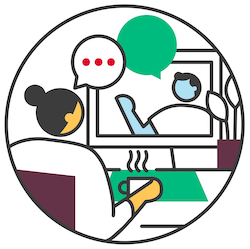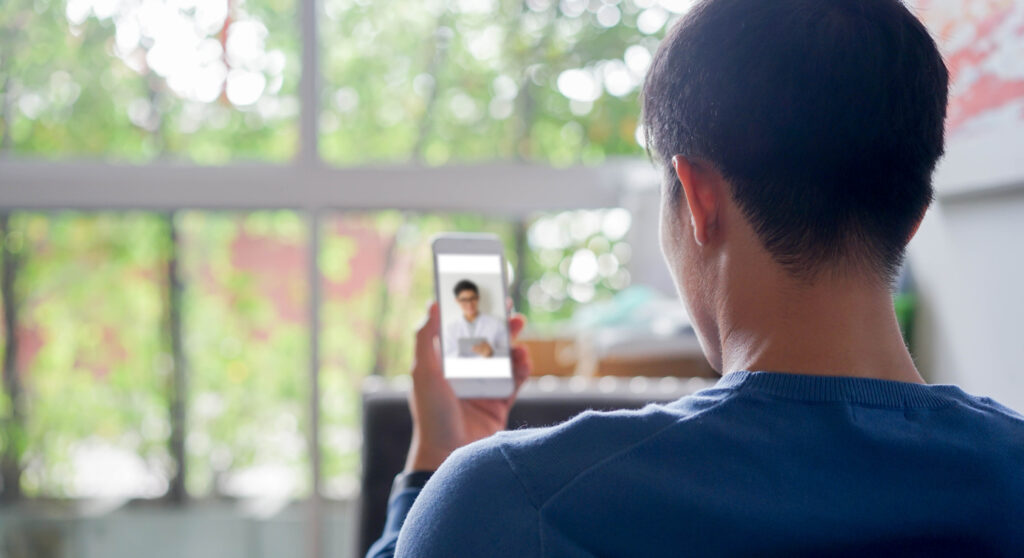What we learned from service users, carers, and mental health staff about access to NHS secondary mental health services during the COVID-19 pandemic


Access to NHS secondary mental health services during the COVID-19 pandemic
During the COVID-19 pandemic, many people experienced worsened mental wellbeing. But while the need for mental health support increased, NHS mental health services were under unprecedented pressures. Lockdown measures affected the way services operated, limiting their ability to support those living with mental health difficulties.
We conducted a study to understand the experiences of people needing to access NHS secondary mental health services, of their carers, and of the members of staff working in these services, during the COVID-19 crisis. Secondary mental health services are those that usually need an initial referral from a GP and are provided by a specialist NHS trust. They include Community Mental Health Teams (CMHT), Crisis and Home Treatment Teams, Assertive Outreach Teams, Early Intervention for Psychosis services, and mental health inpatient units.
To develop the study methods, we worked in consultation with six experts-by-experience (three service users and three carers) and with a peer researcher from the McPin Foundation.
Between May and September 2020, we used Thiscovery to interview 69 people (24 service users, 10 carers, 35 staff) all based in England. Interviews with service users were conducted by a peer researcher who drew on their own experiences of accessing secondary mental health services.
This summary focuses on four key areas of our findings:
- Reorganising services in the face of the COVID-19 crisis
- Experiences of accessing mental health support
- The impact of COVID-19 on carers and on mental health staff
- A move to remote mental healthcare
In-depth interviews held between May and September 2020

Reorganising services in the face of the COVID-19 crisis

Guided by the need to prevent the spread of COVID-19, the pandemic led to a rapid reorganisation of inpatient and community mental health services. Some services changed the way they operated. For example, many switched from in-person consultations to remote ones (via phone or a tablet/computer). Other services – such as family therapy, complex trauma work, day facilities, and memory clinics – were paused. And some inpatient services created bespoke wards for COVID-positive service users and changed their usual criteria for admission and discharge.
These service changes led to some unintended consequences. Quicker discharges from inpatient settings meant that community services had to support more service users than usual. Many of these individuals were very unwell. The creation of ‘COVID’ and ‘non-COVID’ hospital wards resulted, at times, in the merging of units caring for service users with very different care needs. For example, people with dementia and people with severe mental illness were put together in the same space on the basis of whether they had COVID or not, rather than on what would best meet their needs. Some staff were redeployed from their usual roles. This meant they were asked to work in services that they were unfamiliar with, and it often left their usual place of work with fewer staff.
“It kind of went from contact to no contact … It was like, okay, this is what it’s going to be like for me … I’m going to have to get used to not having as much support.”
These changes in service delivery generally seemed to have been made without consultation with service users or with frontline staff. Service users and carers felt let down by this lack of involvement. Many were unsure about whether mental health services were running at all. The uncertainty made it harder to seek the support they needed. Several staff reported that their work with service users at this time focused more on containing risks than on improving people’s mental wellbeing, and they feared the therapeutic function of their role was being lost.
Experiences of accessing mental health support

Changes to mental health services made accessing services more difficult for many service users. Community services ‘re-prioritised’ service users by assigning individuals to a risk category (for example, red, amber, or green), to indicate how urgently and proactively they should be contacted. This meant that people who were categorised as ‘at lower risk’ were no longer regularly contacted by providers. Instead, they were asked to contact the service themselves if they needed support. But in practice, many service users did not feel enabled or empowered to make contact or to access services.
Without regular contact with known professionals, some service users struggled to identify when their mental health was deteriorating. It was also hard for them to know exactly what service providers meant by ‘being in need of support’. Many were uncertain about whether or not they deserved the attention of services. Some people, for example, experienced events that would normally be seen as life crises (such as the death of a family member) but worried these would not be considered ‘severe enough’ in the face of a global pandemic. The result was that they did not seek help from mental health services. And some people did not try to contact services because they did not want to speak with someone they did not know. All these changes meant that service users were more hesitant to seek access to mental health services, and in many cases their wellbeing deteriorated as a result.
Several professionals recognised this problem. They reported that they were particularly worried about what they called the ‘silent’ individuals, such as people who may not see themselves as deserving support and try instead to cope by themselves.
“If you are from a family that are quiet and just get on with it, even though you’re struggling, your voice might not be heard in amongst all of that so, you know, they might get missed.” (Family therapist)
The impact of COVID-19 on mental health staff and carers
Staff provided a vivid account of the impact that the pandemic had on their work and mental health. In many inpatient settings, the decision was made to ‘shield’ consultants from face-to-face work to reduce the risk of contracting COVID-19 and ensure they could continue to lead services. This meant, however, that trainee doctors at the frontline were given greater responsibilities and had to manage difficult and unprecedented situations with reduced support. Some frontline staff also witnessed many service users’ deaths, which they found very difficult.
Some professionals were redeployed to work in services that were understaffed. This typically happened at very short notice and with limited risk-assessment, and some staff reported anxiety at the change. Some staff had to work from home or had to shield for medical reasons. They spoke about the challenges of separating their home and work life, often feeling that they were constantly ‘on call’ or that they were not doing as much as their colleagues onsite.

Most staff recognised that, during the pandemic, mental health services were less able to offer people the support they needed. For many, this was a realisation that induced feelings of guilt and helplessness, to the extent that some experienced moral injury. Some professionals attempted to mitigate this by ‘bending the rules’ (for example, by assigning service users to a higher risk category to justify seeing them in person) but did this at their own risk, which led to further personal strain.
“It’s very uncomfortable … because of all the stuff that’s been put on pause, you’re not left with many tools in your armoury.” (Trainee Psychiatrist)
Carers of service users were also faced with unprecedented pressures. Many experienced a dramatic increase in their caregiving responsibilities, leaving them with little time and energy to consider their own mental wellbeing. Some were worried about the worsening mental health of the person they supported – especially where service provision had been reduced or changed. Other carers, especially those who did not live with the person they supported, felt less able to accurately assess their mental state, and did not know when and how to intervene. Decisions about whether or not to visit service users were made difficult by lockdown restrictions and the risk of spreading COVID-19. Finally, carers’ own support networks were less available during the pandemic. This, along with other practical challenges (such as shopping for groceries), resulted in heightened stress, isolation and, in some cases, burnout.
“I feel the burden of being a carer … I started to get very depressed… very irritable, agitated… To have a sense of hopelessness…” (Carer)
A move to remote mental healthcare

The COVID-19 pandemic forced secondary mental health services to replace much in-person care with remote care (care provided through a telephone, tablet, or a computer). Service users, staff, and carers had varying experiences of this shift. Some of these experiences were positive. Others appeared to accept remote care but still preferred the in-person option. This was especially true for service users who did not have a pre-existing relationship with their clinicians, indicating that building a therapeutic relationship entirely remotely may be particularly challenging. And some service users turned down offers to receive care remotely in the hope that in-person care would be offered again soon. This caused breaks in care that were a cause of concern.
Staff, carers, and some service users indicated that the absence of in-person interactions could make it harder for clinicians to identify risks or other changes to service users’ mental health. Remote consultations also meant that it was not possible to evaluate service users’ home circumstances, and that staff had to rely more heavily on service users’ self-reports. Taken together, these factors may result in fewer preventive measures and, in some cases, avoidable mental health crises.
“Had I seen somebody face to face then maybe things wouldn’t have got so bad … I was still having contact but it was snatched conversations on the phone.” (Service user)
For many, the loss of a safe, private space for clinical interactions was particularly problematic. Some service users were worried about being heard by those who they lived with (a problem that was particularly concerning for those in compromising home-life situations), while staff suffered the loss of an important boundary between work and their personal space. Although many acknowledged the practical benefits of remote care (for example, saving on travelling time) some service users and staff also pointed out that the journey to and from the service was an important opportunity to process the content of clinical interactions.

Several interviewees noted that remote care may be more difficult to access for some people. Examples of these groups included people who don’t trust, have access to, or have confidence with technology, and people with hearing impairments. This could mean that health inequalities could get worse. However, on the other side, some people reported that sometimes remote care can help to tackle inequalities that predated the pandemic associated with face-to-face care. For example, remote care may facilitate access for those who would face a long (or expensive) journey to reach the service, and people with physical impairments who may struggle to travel.
Many staff described remote care as a suitable way of supplementing (rather than substituting) in-person contact. Training to support mental health staff to deliver remote psychological interventions will be key, as will involving service users in decisions about whether remote care is appropriate for them.
“I was never trained in online therapy … sharing thoughts and formulations became more difficult.” (CBT Therapist)
As the role of remote care is likely to remain important after the pandemic, participants emphasised the need to adopt a tailored approach to its use. They wanted the design of services to take into account the needs of service users, the requirements of different types of clinical encounters (for example psychotherapy versus ‘check-ins’ with care coordinators), and the nature of different remote care tools (phone/video calls, emails or texts).
Acknowledgments
We thank all the service users, carers, and members of staff that shared their experiences and contributed to the study: we hope that we have represented your experiences in this summary. We are also sincerely grateful to the service users and carers we consulted with in developing the study design and methodology.
Related content from our open-access series, Elements of Improving Quality and Safety in Healthcare